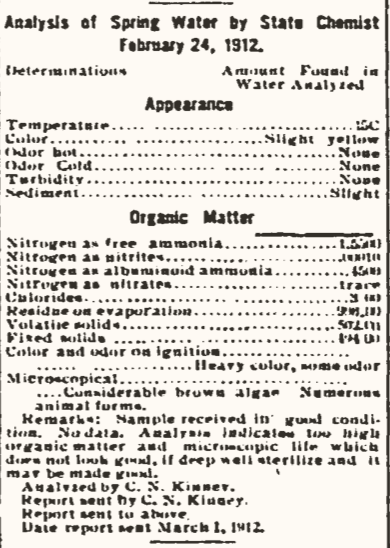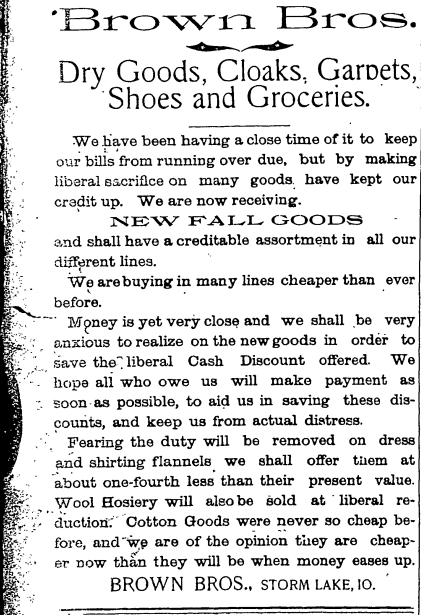by Tim Moyer, Senior History Major
I wanted to contribute to our class on Storm Lake history with an amusing blog post. Over the course of the year we have been looking through the various papers in town and the surrounding area for notable stories from 1880 to 1940. While doing that research, many of us have discovered some fairly strange stories. Some of these came from Storm Lake or the surrounding area, while others on national or international topics were run locally.
A story from 1890 found by Laurel Myers recounted the tale of John Cahoutic, a Scott County man, who claimed that he was being haunted. At night spirts rapped on his windows, stole his chickens, and other bothersome things. To combat this spirit, Cahoutic and John Bernard patrolled the property with guns. One night, Cahoutic thought he finally saw his tormentor and fired. Instead of a ghost, Cahoutic shot Bernard three times, twice in the arm and once in the abdomen.
Two stories dealt with prohibition. I found one from 1930 that involved the arrest of a Newell man, Soren Peterson, for possessing alcohol. Peterson had offered to sell (illegally) some alcohol to a police officer, Deputy Sheriff Roy Gaffin. Even as he was being arrested, Peterson asked what happened to a previous gentleman, who had asked him for alcohol. (This was Gaffin in disguise; Peterson had been thoroughly fooled.)
Piper Nicely found a story three years later describing the breakdown of how counties had voted on the repeal of the 18th Amendment, which showed, for the first time ever, Buena Vista County voting to become a wet county.
Another odd story I found, reporting news elsewhere in the state, was in 1909 when Charles Hickman smelled gas in newly-dedicated Bohemian Turner Hall in Cedar Rapids. When Hickman found the source of the smell–a stove–he (for some reason) lit a match. Guess what happened? Hickman was seriously burned as a result.
Also in 1909, in Davenport Township, Miss Johnson, whom the Storm Lake Pilot Tribune described as the “prettiest teacher in the township,” won a slander case against Harry Martin, winning $1 in the process. The story gives no indication why this specific amount was awarded to Miss Johnson, nor how she had been slandered.
Sam Sutton ran across a story from 1895 of residents, presumably of Dubuque, complaining that it had become nearly impossible to walk around town without the risk of being hit by a cyclist. “There is no place beneath Mrs. Partington’s ‘blue banister’ unless it be on the child-catcher of a trolley car, where the pedestrian is safe from the flying wheel.” Those are some strong words about cyclists, but as Sam mentioned in her note on the story, the feelings remain the same as we at Miami deal with errant cyclists and scooterists all the time on campus.
Caitlin Zawodny read a story in 1919 about the dangers of practical jokes. In Manson, the jokers dressed a dummy in white and suspended it with strings to make it a giant puppet, to scare their target. As a result, the man who was pranked went into convulsions. The article ended with a warning of the dangers of jokes like this one.
Joe Yeager found two stories, both in 1939. One was about a fisherman who had reeled in a bag of stolen items that a thief had thrown into the lake to evade capture. The second was about a farmer preparing to plant spring crops in a field and instead finding it covered in dead turtles. The turtles had died as a result of a flood that had just hit the area.
The last four stories take place beyond Iowa. The first was in Louisiana in 1909. Two men had bet how long a decapitated turtle head would stay alive. The man who claimed to have won the bet said he had guessed 24 hours. At the time of inquiry, it had lasted 25 hours, and the head appeared to continue to live, with opened eyes, trying to bite the other betting man. I have so many questions.
The other story I found was published in three consecutive issues of the Storm Lake Pilot in 1888. It told of a twice-married man from Austria, who had left his family and moved to New York, and who had married a third time. It wasn’t until his second wife came to visit did the trio realize that the man had married his daughter on accident.
Sam Sutton found another odd story where, in Cincinnati in 1895, a man discussed how he trained cockroaches to fight each other in a ring of sand.
The last nugget, found by Paida Hakutangwi in the 1900 papers, described an Englishwoman of Lincolnshire wading into lakes to “farm leeches,” by removing those that had attached themselves to their legs.
All of these stories struck those who found them as bizarre. We are left with more questions than answers.













